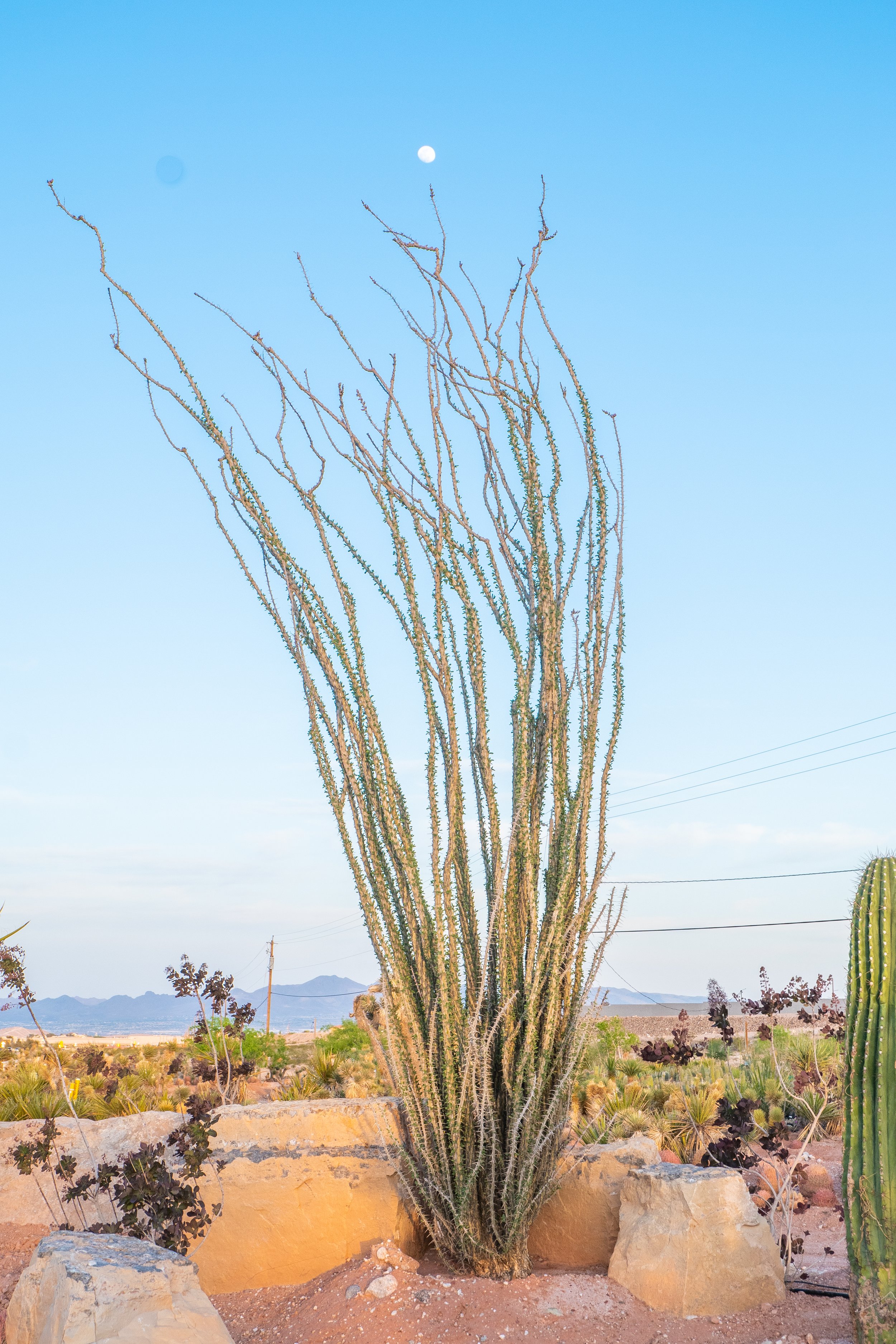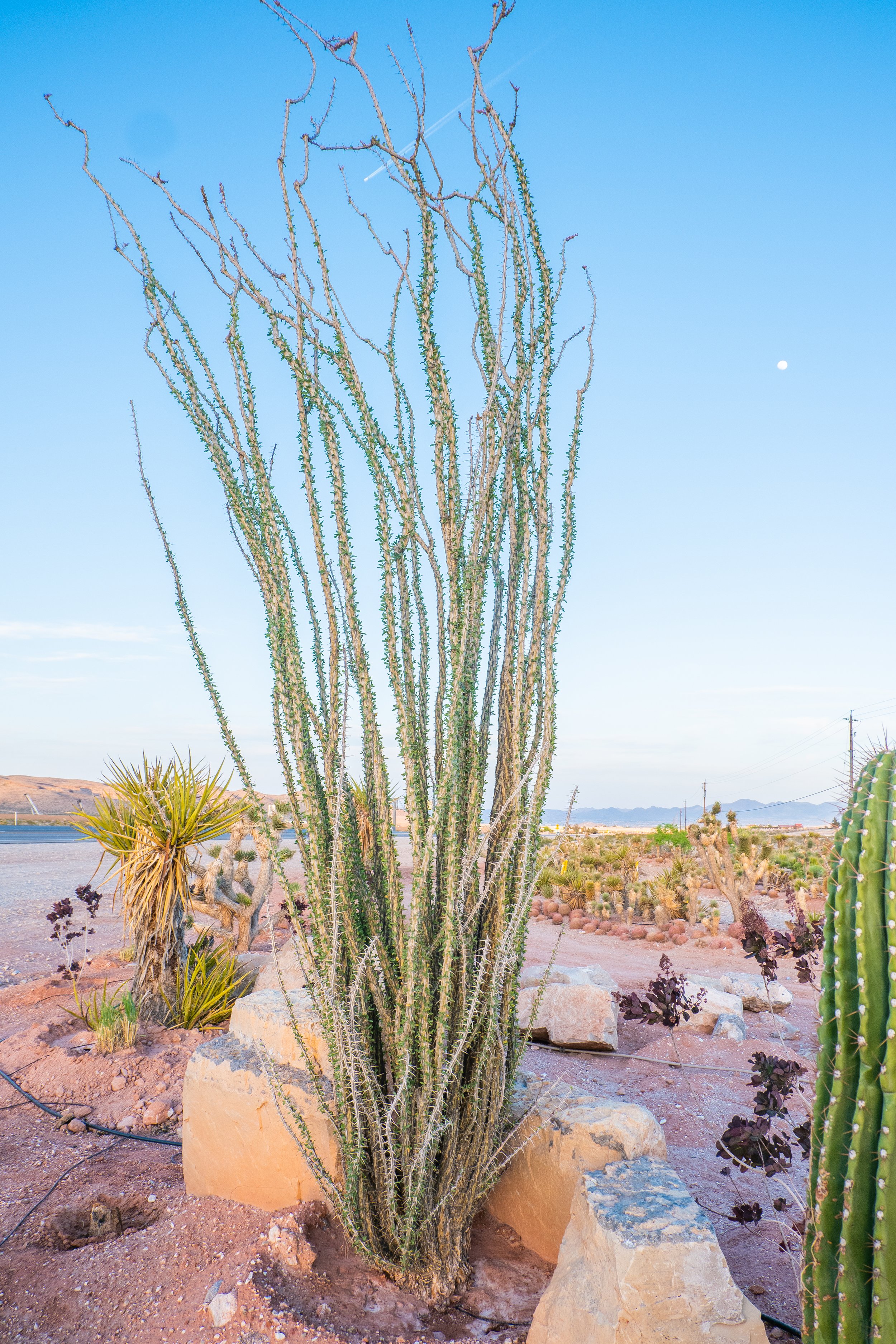 Image 1 of 3
Image 1 of 3

 Image 2 of 3
Image 2 of 3

 Image 3 of 3
Image 3 of 3




Ocotillo
Ocotillo, scientifically known as Fouquieria splendens, is a unique and striking desert shrub native to the southwestern United States and northern Mexico. Here's a detailed overview of its characteristics and care requirements:
Characteristics: Ocotillo is characterized by its tall, slender stems that can grow up to 20 feet tall or more. The stems are covered in small, oval-shaped leaves that are typically deciduous, meaning they may appear and disappear depending on environmental conditions. Ocotillo produces vibrant red-orange flowers at the tips of its stems, typically after periods of rainfall. These flowers attract hummingbirds and other pollinators, adding to the plant's ornamental value.
Cold Hardiness: Ocotillo is adapted to hot, arid climates and is generally hardy to USDA hardiness zones 8a to 11. It can tolerate temperatures as low as 15°F (-9°C) when provided with proper protection from frost and freezing temperatures.
Soil and Water Preferences: Ocotillo thrives in well-draining soil with excellent drainage. It is adapted to sandy or gravelly soil types commonly found in desert regions. While ocotillo can survive extended periods of drought, it benefits from occasional deep watering during periods of prolonged dryness. However, it is important to avoid overwatering, as this can lead to root rot.
Sunlight Needs: Ocotillo prefers full sunlight and thrives in hot, dry conditions. Provide it with plenty of direct sunlight throughout the day for optimal growth and flowering. It can tolerate partial shade, especially during the hottest part of the day in warmer climates, but may not bloom as prolifically in shaded areas.
How to Take Care of it:
Watering: Water sparingly, allowing the soil to dry out between waterings. Deep watering every few weeks during periods of drought can help maintain the health and vigor of the plant.
Sunlight: Place in a location that receives plenty of sunlight, ensuring that the plant receives at least 6 to 8 hours of direct sunlight per day.
Temperature: Protect from frost and freezing temperatures, especially in colder climates. Consider providing winter protection if temperatures drop below freezing.
Soil: Ensure the soil is well-draining to prevent waterlogged conditions, which can lead to root rot.
Pruning: Ocotillo typically does not require pruning, but you can trim back any dead or damaged stems as needed to maintain the plant's shape and appearance.
With proper care and attention to its needs, ocotillo will reward you with its striking form, vibrant blooms, and resilience in arid landscapes.
Ocotillo, scientifically known as Fouquieria splendens, is a unique and striking desert shrub native to the southwestern United States and northern Mexico. Here's a detailed overview of its characteristics and care requirements:
Characteristics: Ocotillo is characterized by its tall, slender stems that can grow up to 20 feet tall or more. The stems are covered in small, oval-shaped leaves that are typically deciduous, meaning they may appear and disappear depending on environmental conditions. Ocotillo produces vibrant red-orange flowers at the tips of its stems, typically after periods of rainfall. These flowers attract hummingbirds and other pollinators, adding to the plant's ornamental value.
Cold Hardiness: Ocotillo is adapted to hot, arid climates and is generally hardy to USDA hardiness zones 8a to 11. It can tolerate temperatures as low as 15°F (-9°C) when provided with proper protection from frost and freezing temperatures.
Soil and Water Preferences: Ocotillo thrives in well-draining soil with excellent drainage. It is adapted to sandy or gravelly soil types commonly found in desert regions. While ocotillo can survive extended periods of drought, it benefits from occasional deep watering during periods of prolonged dryness. However, it is important to avoid overwatering, as this can lead to root rot.
Sunlight Needs: Ocotillo prefers full sunlight and thrives in hot, dry conditions. Provide it with plenty of direct sunlight throughout the day for optimal growth and flowering. It can tolerate partial shade, especially during the hottest part of the day in warmer climates, but may not bloom as prolifically in shaded areas.
How to Take Care of it:
Watering: Water sparingly, allowing the soil to dry out between waterings. Deep watering every few weeks during periods of drought can help maintain the health and vigor of the plant.
Sunlight: Place in a location that receives plenty of sunlight, ensuring that the plant receives at least 6 to 8 hours of direct sunlight per day.
Temperature: Protect from frost and freezing temperatures, especially in colder climates. Consider providing winter protection if temperatures drop below freezing.
Soil: Ensure the soil is well-draining to prevent waterlogged conditions, which can lead to root rot.
Pruning: Ocotillo typically does not require pruning, but you can trim back any dead or damaged stems as needed to maintain the plant's shape and appearance.
With proper care and attention to its needs, ocotillo will reward you with its striking form, vibrant blooms, and resilience in arid landscapes.
Ocotillo, scientifically known as Fouquieria splendens, is a unique and striking desert shrub native to the southwestern United States and northern Mexico. Here's a detailed overview of its characteristics and care requirements:
Characteristics: Ocotillo is characterized by its tall, slender stems that can grow up to 20 feet tall or more. The stems are covered in small, oval-shaped leaves that are typically deciduous, meaning they may appear and disappear depending on environmental conditions. Ocotillo produces vibrant red-orange flowers at the tips of its stems, typically after periods of rainfall. These flowers attract hummingbirds and other pollinators, adding to the plant's ornamental value.
Cold Hardiness: Ocotillo is adapted to hot, arid climates and is generally hardy to USDA hardiness zones 8a to 11. It can tolerate temperatures as low as 15°F (-9°C) when provided with proper protection from frost and freezing temperatures.
Soil and Water Preferences: Ocotillo thrives in well-draining soil with excellent drainage. It is adapted to sandy or gravelly soil types commonly found in desert regions. While ocotillo can survive extended periods of drought, it benefits from occasional deep watering during periods of prolonged dryness. However, it is important to avoid overwatering, as this can lead to root rot.
Sunlight Needs: Ocotillo prefers full sunlight and thrives in hot, dry conditions. Provide it with plenty of direct sunlight throughout the day for optimal growth and flowering. It can tolerate partial shade, especially during the hottest part of the day in warmer climates, but may not bloom as prolifically in shaded areas.
How to Take Care of it:
Watering: Water sparingly, allowing the soil to dry out between waterings. Deep watering every few weeks during periods of drought can help maintain the health and vigor of the plant.
Sunlight: Place in a location that receives plenty of sunlight, ensuring that the plant receives at least 6 to 8 hours of direct sunlight per day.
Temperature: Protect from frost and freezing temperatures, especially in colder climates. Consider providing winter protection if temperatures drop below freezing.
Soil: Ensure the soil is well-draining to prevent waterlogged conditions, which can lead to root rot.
Pruning: Ocotillo typically does not require pruning, but you can trim back any dead or damaged stems as needed to maintain the plant's shape and appearance.
With proper care and attention to its needs, ocotillo will reward you with its striking form, vibrant blooms, and resilience in arid landscapes.
